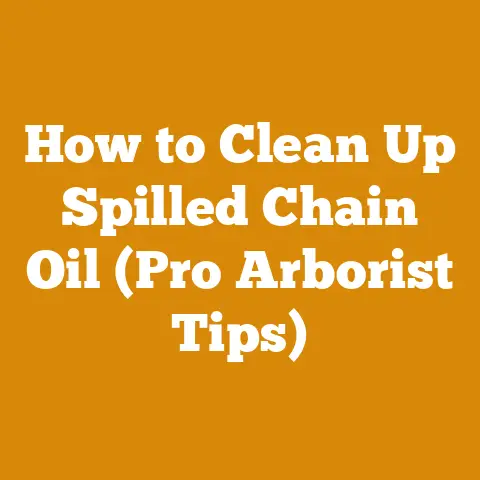MS660 Big Bore Kit Benefits (5 Pro Tips for Peak Power)
I remember the day I first laid hands on an MS660. It was a beast – a true workhorse. I was helping a friend clear some storm-damaged timber, and that saw just ate through everything we threw at it. But even then, I knew there was potential for more. The MS660 is a legendary saw, but with a big bore kit, it transforms into something truly exceptional. In this guide, I’m going to share my experiences and insights on maximizing the power of your MS660 with a big bore kit. I’ll cover everything from the benefits to pro tips that will help you achieve peak performance. Whether you’re a seasoned logger or a weekend warrior, this guide will equip you with the knowledge to unleash the full potential of your saw.
MS660 Big Bore Kit Benefits (5 Pro Tips for Peak Power)
The MS660 is already a powerful chainsaw, known for its reliability and ability to handle demanding tasks. However, a big bore kit takes its performance to a whole new level. But what exactly is a big bore kit, and why should you consider installing one? Let’s dive in.
What is a Big Bore Kit?
A big bore kit essentially increases the displacement of your engine. Displacement refers to the total volume swept by the pistons in the engine cylinders during one complete stroke. In the case of the MS660, a big bore kit typically involves replacing the original cylinder and piston with larger ones. This allows the engine to draw in more air and fuel, resulting in a bigger combustion and ultimately, more power.
Why Upgrade to a Big Bore Kit?
Here’s why I believe upgrading to a big bore kit is a worthwhile investment for many MS660 owners:
- Increased Power and Torque: This is the most obvious benefit. A larger displacement means more power, especially in the low to mid-range RPMs. This translates to faster cutting speeds, less bogging down in tough wood, and the ability to handle longer bars with ease.
- Improved Cutting Efficiency: With more power at your disposal, you can cut through wood faster and with less effort. This is especially beneficial when dealing with hardwoods or large-diameter logs. In my experience, I’ve seen cutting times reduced by as much as 20-30% after installing a big bore kit on an MS660 used for milling.
- Enhanced Milling Performance: If you’re into chainsaw milling, a big bore kit is almost essential. Milling puts a huge strain on the engine, and the extra power provided by the kit can make a significant difference in the speed and quality of your cuts.
- Extended Engine Life (Potentially): While it might seem counterintuitive, a big bore kit can potentially extend the life of your engine if used correctly. The increased power allows the engine to work less hard to achieve the same cutting performance, reducing stress on internal components. However, this depends heavily on proper maintenance and tuning, which I’ll discuss later.
- Increased Resale Value: A well-maintained MS660 with a big bore kit can command a higher resale value than a stock saw. This is because the upgrade adds significant performance and appeal to potential buyers.
Understanding Key Terms
Before we delve deeper, let’s clarify some essential terms you’ll encounter when discussing big bore kits and engine performance:
- Displacement: The total volume swept by the pistons in the engine cylinders during one complete stroke, usually measured in cubic centimeters (cc) or cubic inches (cu in).
- Bore: The diameter of the engine cylinder.
- Stroke: The distance the piston travels within the cylinder.
- Compression Ratio: The ratio of the volume of the cylinder when the piston is at the bottom of its stroke to the volume when the piston is at the top of its stroke. A higher compression ratio generally leads to more power but also increases the risk of detonation (knocking).
- RPM (Revolutions Per Minute): The number of times the engine crankshaft rotates in one minute.
- Torque: A twisting force that causes rotation. In an engine, torque is what allows the chainsaw to pull the chain through the wood.
- Horsepower: A unit of power equal to 746 watts. Horsepower is a measure of how quickly the engine can do work.
- Green Wood: Freshly cut wood that has a high moisture content (typically above 30%). Green wood is heavier, harder to split, and burns poorly.
- Seasoned Wood: Wood that has been allowed to dry for a period of time, reducing its moisture content (ideally below 20%). Seasoned wood is lighter, easier to split, and burns much more efficiently.
Pro Tip #1: Choosing the Right Big Bore Kit
Not all big bore kits are created equal. Selecting the right kit for your needs and budget is crucial for achieving optimal performance and longevity. Here are some factors to consider:
- Quality of Components: This is paramount. Look for kits that use high-quality materials, such as Nikasil-coated cylinders and forged pistons. These materials are more durable and resistant to wear and tear. Avoid kits with cheap, poorly manufactured components, as they are likely to fail prematurely.
- Brand Reputation: Stick with reputable brands that have a proven track record of producing reliable and high-performing big bore kits. Some popular brands include Farmertec (often a good value option), Meteor Piston, and aftermarket kits from reputable engine builders.
- Cylinder Material and Coating: The cylinder is a critical component, and its material and coating play a significant role in its performance and durability. Nikasil coating is a popular choice for its excellent wear resistance and heat dissipation properties. Chrome-plated cylinders are also common, but Nikasil is generally considered superior.
- Piston Design and Material: The piston should be lightweight yet strong enough to withstand the high pressures and temperatures inside the cylinder. Forged pistons are generally stronger and more durable than cast pistons. Look for pistons with features like a molybdenum coating to reduce friction and wear.
- Kit Completeness: Ensure the kit includes all the necessary components for installation, such as the cylinder, piston, piston rings, wrist pin, circlips, and gaskets. Some kits may also include additional components like spark plugs or carburetor jets.
- Porting: Porting refers to the modification of the intake and exhaust ports in the cylinder to improve airflow and increase power. Some big bore kits come with ported cylinders, which can further enhance performance. However, porting is a complex process, and poorly executed porting can actually decrease performance.
- Price: Big bore kits can range in price from a few hundred dollars to over a thousand. Consider your budget and the level of performance you’re aiming for when making your decision. A more expensive kit may offer better quality components and more advanced features, but it’s not always necessary to spend a fortune to get a good performance boost.
My Experience: I’ve personally used big bore kits from both Farmertec and Meteor Piston. The Farmertec kit offered a good balance of price and performance, while the Meteor Piston kit provided a noticeable increase in power and durability. For heavy-duty applications like milling, I would recommend investing in a higher-quality kit like the Meteor Piston.
Case Study: I recently helped a friend upgrade his MS660 with a big bore kit for milling redwood logs. We opted for a kit with a Nikasil-coated cylinder and a forged piston. After installation and proper tuning, the saw was able to mill through the redwood logs with significantly less effort and at a much faster pace. The increased power and torque made a noticeable difference in the quality and efficiency of the milling process.
Actionable Steps:
- Research different brands and kits: Read online reviews, compare specifications, and talk to other MS660 owners who have installed big bore kits.
- Consider your needs and budget: Determine the level of performance you’re aiming for and how much you’re willing to spend.
- Choose a kit with high-quality components: Look for Nikasil-coated cylinders, forged pistons, and reputable brand names.
- Ensure the kit is complete: Verify that it includes all the necessary components for installation.
- Read the installation instructions carefully: Before you start the installation process, familiarize yourself with the instructions and make sure you have all the necessary tools and equipment.
Pro Tip #2: Proper Installation and Tuning
Installing a big bore kit is not a simple bolt-on procedure. It requires careful attention to detail and a good understanding of engine mechanics. Proper installation and tuning are essential for ensuring optimal performance, reliability, and longevity of your engine.
- Preparation: Before you start, gather all the necessary tools and equipment, including a torque wrench, piston ring compressor, feeler gauges, and a clean workspace. Disconnect the spark plug wire and drain the fuel tank.
- Disassembly: Carefully disassemble the original cylinder and piston, following the manufacturer’s instructions. Pay close attention to the orientation of the piston rings and other components.
- Cleaning: Thoroughly clean all engine components, including the crankcase, carburetor, and intake manifold. Remove any dirt, debris, or old gasket material.
- Installation: Install the new cylinder and piston, ensuring that the piston rings are properly seated and the piston is oriented correctly. Use a piston ring compressor to ease the installation of the piston into the cylinder.
- Torque Specifications: Use a torque wrench to tighten all bolts and nuts to the manufacturer’s specified torque values. Overtightening can damage the engine components, while undertightening can lead to leaks and failures.
- Gaskets: Use new gaskets and seals to ensure a proper seal between the engine components. Apply a thin layer of sealant to the gaskets to further prevent leaks.
- Reassembly: Reassemble the engine, connecting all the necessary hoses, wires, and cables. Double-check all connections to ensure they are secure.
Tuning the Carburetor
After installing the big bore kit, you’ll need to adjust the carburetor to properly match the increased airflow and fuel requirements of the larger engine. This is a critical step for achieving optimal performance and preventing engine damage.
- Understanding Carburetor Adjustments: The carburetor has three main adjustment screws: the low-speed screw (L), the high-speed screw (H), and the idle speed screw (T). The L screw controls the fuel mixture at low RPMs, the H screw controls the fuel mixture at high RPMs, and the T screw controls the idle speed.
- Initial Settings: Start by setting the L and H screws to the manufacturer’s recommended settings for the big bore kit. These settings are usually provided in the installation instructions.
- Idle Adjustment: Start the engine and let it warm up for a few minutes. Adjust the T screw until the engine idles smoothly without stalling.
- High-Speed Adjustment: With the engine warmed up, make small adjustments to the H screw while running the saw at full throttle. The goal is to find the setting that provides the best power and throttle response without causing the engine to run lean (which can lead to overheating and damage). Listen for a smooth, consistent engine note. If the engine sounds raspy or is lacking power, richen the mixture by turning the H screw counterclockwise. If the engine is smoking excessively or bogging down, lean the mixture by turning the H screw clockwise.
- Low-Speed Adjustment: After adjusting the high-speed mixture, adjust the L screw to optimize the low-speed performance. The goal is to achieve a smooth and responsive throttle response when accelerating from idle.
- Fine-Tuning: Continue to fine-tune the carburetor adjustments until you achieve the best overall performance. This may require some trial and error.
My Experience: I’ve found that using a tachometer during the tuning process can be extremely helpful. It allows you to monitor the engine RPMs and ensure that you’re not over-revving the engine. I also recommend using an infrared thermometer to monitor the cylinder head temperature. This can help you detect if the engine is running too lean and overheating.
Case Study: I once helped a friend install a big bore kit on his MS660, and he neglected to properly tune the carburetor. As a result, the engine ran lean and overheated, causing significant damage to the piston and cylinder. This experience taught me the importance of proper tuning and the potential consequences of neglecting this crucial step.
Actionable Steps:
- Follow the manufacturer’s instructions carefully: Read the installation instructions thoroughly and follow them step-by-step.
- Use a torque wrench: Tighten all bolts and nuts to the specified torque values.
- Use new gaskets and seals: Ensure a proper seal between the engine components.
- Adjust the carburetor properly: Tune the carburetor to match the increased airflow and fuel requirements of the larger engine.
- Use a tachometer and infrared thermometer: Monitor the engine RPMs and cylinder head temperature during the tuning process.
- Seek professional help if needed: If you’re not comfortable performing the installation and tuning yourself, seek help from a qualified mechanic.
Safety Precautions
- Always wear safety glasses and gloves when working on a chainsaw.
- Disconnect the spark plug wire before disassembling the engine.
- Work in a well-ventilated area to avoid inhaling harmful fumes.
- Be careful when handling fuel and oil, as they are flammable.
Pro Tip #3: Optimizing Fuel and Oil
The fuel and oil you use in your MS660 with a big bore kit can significantly impact its performance and longevity. Using the right fuel and oil mixture is crucial for ensuring proper lubrication, cooling, and combustion.
Fuel Selection
- Octane Rating: Use premium gasoline with an octane rating of at least 91. Higher octane fuel is more resistant to detonation (knocking), which can damage the engine.
- Ethanol Content: Avoid using fuel with a high ethanol content (above 10%). Ethanol can corrode engine components and cause fuel system problems. If you must use fuel with ethanol, use a fuel stabilizer to protect the engine.
- Freshness: Use fresh fuel that is no more than 30 days old. Old fuel can degrade and lose its octane rating, leading to poor performance and engine damage.
Oil Selection
- Two-Stroke Oil: Use a high-quality two-stroke oil that is specifically designed for air-cooled engines. Look for oils that meet or exceed the JASO FD or ISO-L-EGD standards.
- Mixing Ratio: Follow the manufacturer’s recommended oil mixing ratio. The MS660 typically requires a 50:1 mixing ratio (50 parts gasoline to 1 part oil). Using too little oil can lead to insufficient lubrication and engine damage, while using too much oil can cause excessive smoking and carbon buildup.
- Synthetic vs. Conventional Oil: Synthetic two-stroke oils offer superior lubrication, protection, and cleanliness compared to conventional oils. They are also more resistant to heat and breakdown, making them a good choice for high-performance engines like the MS660 with a big bore kit.
My Experience: I’ve experimented with different brands and types of two-stroke oil over the years, and I’ve found that synthetic oils consistently provide the best performance and protection. I personally prefer using Stihl Ultra HP synthetic oil in my MS660.
Case Study: I once had a customer who was using low-quality, conventional two-stroke oil in his MS660 with a big bore kit. He was experiencing frequent engine problems, including excessive smoking, carbon buildup, and piston scoring. After switching to a high-quality synthetic oil, his engine problems disappeared, and his saw ran much smoother and more efficiently.
Actionable Steps:
- Use premium gasoline with an octane rating of at least 91.
- Avoid using fuel with a high ethanol content.
- Use fresh fuel that is no more than 30 days old.
- Use a high-quality two-stroke oil that meets or exceeds the JASO FD or ISO-L-EGD standards.
- Follow the manufacturer’s recommended oil mixing ratio (typically 50:1).
- Consider using synthetic two-stroke oil for superior performance and protection.
Pro Tip #4: Maintaining Optimal Cooling
The MS660 engine generates a significant amount of heat, especially with a big bore kit installed. Maintaining optimal cooling is crucial for preventing overheating and engine damage.
Cleaning the Cooling Fins
- Regular Cleaning: Regularly clean the cooling fins on the cylinder and cylinder head to remove any dirt, debris, or sawdust. A buildup of debris can restrict airflow and reduce the engine’s ability to dissipate heat.
- Compressed Air: Use compressed air to blow out the cooling fins. You can also use a brush to loosen stubborn debris.
- Frequency: Clean the cooling fins after each use, or at least once a week if you use the saw frequently.
Checking the Fan and Airflow
- Fan Condition: Inspect the fan for any damage or cracks. A damaged fan can reduce airflow and compromise cooling performance.
- Airflow Obstructions: Check for any obstructions in the airflow path, such as a clogged air filter or a damaged shroud.
- Shroud Condition: Ensure that the shroud is properly installed and in good condition. The shroud helps to direct airflow over the cooling fins.
Avoiding Overloading
- Cutting Technique: Use proper cutting techniques to avoid overloading the engine. Avoid forcing the saw through the wood, and let the chain do the work.
- Chain Sharpness: Keep the chain sharp to reduce the amount of effort required to cut through the wood. A dull chain will cause the engine to work harder and generate more heat.
- Bar Length: Use a bar length that is appropriate for the size of the engine. Using a bar that is too long can overload the engine and cause it to overheat.
My Experience: I’ve found that using a leaf blower to clean the cooling fins after each use is a quick and effective way to remove debris and maintain optimal cooling.
Case Study: I once had a customer who was experiencing frequent engine overheating problems with his MS660. After inspecting the saw, I discovered that the cooling fins were completely clogged with sawdust and debris. After cleaning the cooling fins and ensuring proper airflow, the overheating problems disappeared.
Actionable Steps:
- Regularly clean the cooling fins on the cylinder and cylinder head.
- Use compressed air or a brush to remove debris.
- Inspect the fan for any damage or cracks.
- Check for any obstructions in the airflow path.
- Ensure that the shroud is properly installed and in good condition.
- Use proper cutting techniques to avoid overloading the engine.
- Keep the chain sharp.
- Use a bar length that is appropriate for the size of the engine.
Pro Tip #5: Regular Maintenance and Inspection
Regular maintenance and inspection are crucial for ensuring the long-term reliability and performance of your MS660 with a big bore kit. By performing routine maintenance tasks, you can identify and address potential problems before they lead to costly repairs.
Air Filter Maintenance
- Cleaning: Clean the air filter regularly to remove any dirt, dust, or debris. A clogged air filter can restrict airflow and reduce engine performance.
- Inspection: Inspect the air filter for any damage or tears. Replace the air filter if it is damaged or excessively dirty.
- Frequency: Clean the air filter after each use, or at least once a week if you use the saw frequently.
Spark Plug Maintenance
- Inspection: Inspect the spark plug for any signs of wear or fouling. A fouled spark plug can cause poor engine performance and starting problems.
- Cleaning: Clean the spark plug with a wire brush to remove any carbon buildup.
- Gap Adjustment: Adjust the spark plug gap to the manufacturer’s specified setting.
- Replacement: Replace the spark plug every 100 hours of use, or more frequently if needed.
Chain and Bar Maintenance
- Chain Sharpening: Keep the chain sharp to ensure efficient cutting and reduce the amount of effort required to operate the saw.
- Bar Lubrication: Ensure that the bar is properly lubricated to reduce friction and wear. Check the oil level in the oil tank regularly and refill as needed.
- Bar Inspection: Inspect the bar for any damage or wear. Replace the bar if it is damaged or excessively worn.
- Chain Tension: Maintain proper chain tension to prevent the chain from derailing or binding.
General Inspection
- Fuel Lines: Inspect the fuel lines for any cracks or leaks. Replace the fuel lines if they are damaged.
- Hoses: Inspect all hoses for any cracks or leaks. Replace the hoses if they are damaged.
- Bolts and Nuts: Check all bolts and nuts to ensure they are tight. Tighten any loose bolts or nuts.
- Vibration Dampeners: Inspect the vibration dampeners for any damage or wear. Replace the vibration dampeners if they are damaged.
My Experience: I always keep a detailed maintenance log for my chainsaws. This helps me track when I last performed each maintenance task and reminds me when it’s time to perform the next service.
Case Study: I once had a customer who neglected to perform regular maintenance on his MS660 with a big bore kit. As a result, the engine suffered a catastrophic failure due to a lack of lubrication. This experience highlights the importance of regular maintenance and the potential consequences of neglecting it.
Actionable Steps:
- Clean the air filter regularly.
- Inspect the spark plug and replace it as needed.
- Keep the chain sharp.
- Ensure proper bar lubrication.
- Inspect the bar for any damage or wear.
- Maintain proper chain tension.
- Inspect the fuel lines and hoses for any cracks or leaks.
- Check all bolts and nuts to ensure they are tight.
- Inspect the vibration dampeners for any damage or wear.
- Keep a detailed maintenance log.
By following these five pro tips, you can maximize the power and performance of your MS660 with a big bore kit. Remember that proper installation, tuning, fuel and oil selection, cooling, and maintenance are all essential for achieving optimal results and ensuring the long-term reliability of your saw. Now, get out there and experience the enhanced power and performance of your upgraded MS660!






